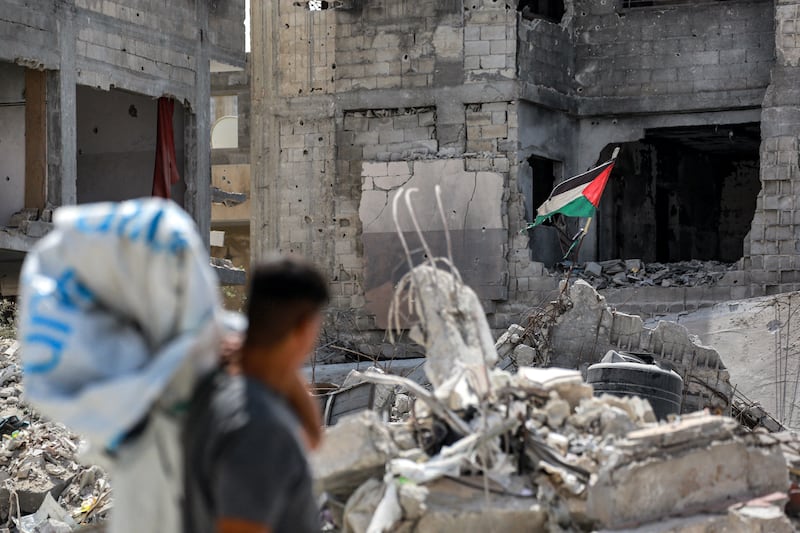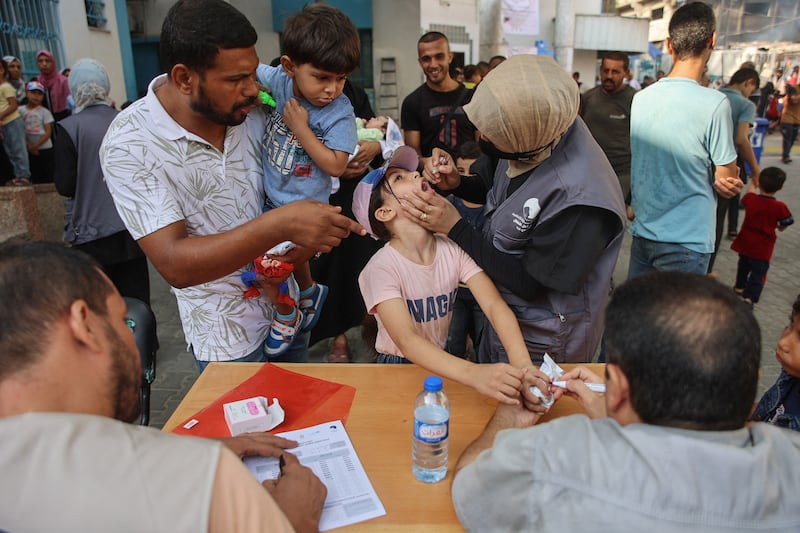At least 16 people were killed in Israeli air strikes across central Gaza on Sunday night and Monday morning, including five women and four children, Palestinian health officials said.
Rescuers said an air strike early on Monday destroyed a residential building in the densely populated Nuseirat refugee camp in the heart of central Gaza, killing at least 10 people, including four women and two children.
The al-Awda hospital, which received the bodies, confirmed the deaths and said another 13 people were wounded. Hospital records quoted by local media show that the dead included a mother, her child and her five siblings.
In a separate strike targeting a building in Gaza City, six individuals lost their lives. A woman and two children were among the dead, according to the civil defence, a team of emergency responders working under the governance of Hamas.
READ MORE
Israel says its military operations exclusively target combatants and claims Hamas and other armed factions place civilians at risk by operating within residential areas.
Eleven months into the Gaza war, the death toll among Palestinians has passed 41,000, according to health authorities in the territory. Most of the dead are civilians and the total is nearly 2 per cent of Gaza’s pre-war population, or equal to one in every 50 people. The conflict was triggered by Hamas’s October 7th attack on Israel, in which 1,200 people died and about 250 were taken hostage.

On Sunday evening, a senior Hamas official told Agence France-Presse that new generations of fighters had been recruited since the October 7th attacks, less than a week after the Israeli defence minister, Yoav Gallant, told journalists that Hamas “no longer exists” as a military formation in Gaza.
During an interview in Istanbul, Osama Hamdan claimed that the militant group “has a high ability to continue”.
He added: “There were martyrs and there were sacrifices ... but in return there was an accumulation of experiences and the recruitment of new generations into the resistance.”
Hamdan spoke of a surface-to-surface missile that reached central Israel for the first time on Sunday, causing a fire near Kfar Daniel.
The Hamas official said the attack, claimed by Yemen’s Houthi rebels, showed the limits of Israel’s ability to defend itself, including its aerial defence system. “It is a message to the entire region that Israel is not an immune entity,” Mr Hamdan said. “Even Israeli capabilities have limits.”
The Israeli military is investigating whether the fire was the result of falling fragments caused by interceptor missiles launched at the projectile, or if it successfully penetrated its air defences, as the Houthis have claimed.
The Israeli prime minister, Binyamin Netanyahu, said the Houthis would pay a “heavy price”, while the Houthi leader warned of bigger attacks to come.
On Monday, the Houthi military spokesperson, Yahya Saree, said the group downed a US MQ-9 drone in Yemen’s Dhamar province.
In a separate development on Monday, Gallant told the US defence secretary, Lloyd Austin, that time was running out for an agreement with Hizbullah to halt the fighting along the Israel-Lebanon border, where on Sunday the Israeli military reported that approximately 40 projectiles had been launched, with the majority being intercepted or landing in uninhabited regions.
“The possibility for an agreed framework in the northern arena is running out as Hizbullah continues to ‘tie itself’ to Hamas,” Mr Gallant said, “The trajectory is clear.”
Hizbullah said it would halt its attacks if there was a ceasefire in Gaza, but months of talks brokered by the US, Qatar and Egypt have repeatedly stalled.
Mr Gallant told Austin that “in any possible scenario, Israel’s defence establishment will continue to operate with the aim of dismantling Hamas and ensuring the return of hostages held by Hamas in Gaza – by any means”.
Meanwhile, media reports in Israel suggested Mr Gallant’s position could be under threat, with sources in the prime minister’s office saying Netanyahu was considering appointing the New Hope chair, Gideon Sa’ar, as Mr Gallant’s replacement.
After the report, the far-right national security minister, Itamar Ben-Gvir, said on X “the time has come to [fire Gallant] immediately”.
Rumours that Mr Netanyahu would replace Mr Gallant have been circulating for months. The already strained relationship between the two has been tumultuous since Mr Netanyahu’s sudden decision to dismiss Mr Gallant in March 2023 because of his vocal disapproval of the government’s judicial changes. However, the prime minister’s move was later rescinded after public outcry.
Some in Mr Netanyahu’s administration have called for Mr Gallant’s removal, citing a range of grievances including his stance against a government-supported ultra-Orthodox enlistment bill and his public disagreement with the prime minister on matters such as a hostage negotiation and Israel’s presence in the Philadelphi corridor on the Gaza-Egypt border.

Meanwhile, polio vaccination coverage in Gaza has reached 90 per cent, the head of the United Nations Palestinian refugee agency said on Monday, adding that the next step was to ensure hundreds of thousands of children got a second dose at the end of the month.
The campaign to vaccinate some 640,000 children in Gaza under 10 years of age against polio, which began on September 1st, presented major challenges to Unrwa and its partners due to the ongoing conflict between Israel and Hamas.
It followed confirmation by the World Health Organisation last month that a baby had been partially paralysed by the type 2 polio virus, the first such case in the Palestinian territory in 25 years.
More than 446,000 Palestinian children in central and south Gaza were vaccinated earlier this month before a campaign to vaccinate a final 200,000 children in north Gaza began on September 10th despite access restrictions, evacuation orders and shortages of fuel.
The first round of the polio vaccination campaign in Gaza ended successfully, Unrwa’s chief Philippe Lazzarini said, adding that 90 per cent of the enclave’s children had received a first dose.
“Parties to the conflict have largely respected the different required “humanitarian pauses” showing that when there is a political will, assistance can be provided without disruption. Our next challenge is to provide children with their second dose at the end of September,” he wrote on X. – Guardian/Reuters
- Sign up for push alerts and have the best news, analysis and comment delivered directly to your phone
- Join The Irish Times on WhatsApp and stay up to date
- Listen to our Inside Politics podcast for the best political chat and analysis












